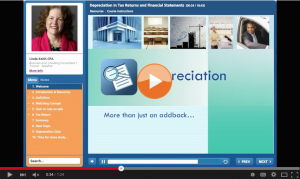Mark’s question:
I have a loan prospect who has provided me with three years of Schedule E’s reporting rental income and operating expenses on a 3 unit apartment building. In each of the three years, the rental income is minimal because the units were being renovated and vacant for the majority of the full 12 months.
Where would I see the renovation costs? Does it make a difference that they were funded by personal credit card? On the depreciation report, there are line items for “5-Year GDS Property”, “20-year GDS Property” and “Prior MACRS”. Would any of those lines include improvements to the property?
Linda says:
All three of your questions relate to capitalizing of expenditures (the renovation) and then depreciation of those capitalized expenditures. I’ll cover both. And I have a different answer depending on whether you are a personal lender, a business lender or an AgLender.
Capitalize vs Expense
We enter an expenditure as an expense when it benefits us right now. We capitalize an expenditure when it is expected to provide future value. I would expense travel costs to a convention but I would capitalize the airplane I use to take me there. Well, if it were my company’s airplane!
The Matching Concept
This choice between capitalizing and expensing demonstrates the matching concept at work. In Generally Accepted Accounting Principles (GAAP), we attempt to match the cost of something with the period of time it helps us generate revenue. In a small restaurant, the supplies that will be used up within a month or cost a relatively small amount will be expensed. It is helping us create revenue right now.
But the $10,000 stove is going to help us out for years. If it were good for five years, only $2,000 of that amount might be “written off” each year. Because we want to accurately reflect the cost of operations for the year, we’ll capitalize the stove and write it off over the five years. The write-off is called “depreciation”.
Renovation costs are capitalized no matter how they are financed
Whether the renovation costs are paid for in cash, on charge cards or through a loan is not relevant to how we treat them. Since these costs will increase the value or life of the building, we will create an asset and write it off over time through depreciation.
More on Depreciation: Straight-line vs Accelerated
The example above used straight-line depreciation. I just divided the $10,000 by five years to come up with $2,000 per year. Easy.
Accelerated depreciation recognizes that we get more use out of an asset when it is new. It is often more efficient at that time in the life-cycle, and there are lower repair and maintenance costs. Most business financial statements use this approach.
Depreciation on Tax Returns
GDS stands for General Depreciation System and is most often used under the MACRS system. MACRS stands for Modified Accelerted Cost Recovery System.
You refer to 5-year and 20-year property. My guess is the 5-year property related to your renovation is appliances. Here is the break-down:
5-year property
- Automobiles, taxis, buses, and trucks.
- Computers and peripheral equipment.
- Office machinery (such as typewriters, calculators, and copiers).
- Any property used in research and experimentation.
- Breeding cattle and dairy cattle.
- Appliances, carpets, furniture, etc., used in a residential rental real estate activity.
- Certain geothermal, solar, and wind energy property
20 year property
- Farm buildings (other than single purpose agricultural or horticultural structures).
- Municipal sewers not classified as 25-year property.
- Initial clearing and grading land improvements for electric utility transmission and distribution plants
How AgLenders see it
Farm lenders use tax return analysis for two purposes: earnings analysis and debt repayment capacity analysis. Not specific to renovation, but on a farm tax return AgLenders regularly replace whatever is on the depreciation line with a substituted “use cost” or “normalized depreciation”. Their software may use the income statement portion of their worksheet for earnings analysis and they recognize that whatever is in the return is using tax rules, not GAAP.
The AgLender might use 20% of equipment in service, for example, which presumes that type of equipment needs to be replaced every five years. Then they put their substitute number on a line where their software will add it back for the capital debt repayment part of the analysis.
Want more?
We have an online module that dives in deeper. It is on our completely self-study online training site: www.LendersOnlineTraining.com. Here is the link:

